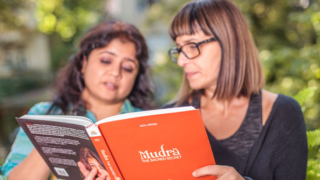Have you ever wondered why do we chant Shanti 3 times at the end of a yoga class and Om three times at the beginning of a session? Why does it matter?
3 types of Suffering
According to the vedic texts, there are 3 types of suffering that a being experiences throughout the life span. All types of sufferings can be grouped under these three:
- Adhi-daivika- The suffering caused by natural forces, acts of God, need divine interpretations or as a result of karmic resolution. For example all kinds of floods, tornadoes, earth quakes, avalanches, drought come under this category. Let there be peace so that there is no Adhi-daivika sufferings. May the Gods and Mother nature be appeased with our gratitude, thankfulness and may it brings forth peace and only peace.
- Adhi-bhautika- The suffering caused by Bhutas. Any other being is called a bhuta. When the harm, injury, disease is caused by any other being that pervade the earth space. For example suffering caused by another human being, war fare, conflicts between people, an animal, insect, bacteria, virus. Let there be peace so that there are no Adhi-bhautika sufferings. May other beings be not the cause of pain, suffering, harm or injury to anyone.
- Adhya-atmika- The suffering causes by ignorance, lack of knowledge and lack of harmony at the physical, mental, emotional level. The diseases of the body, breath and mind come in this category. May there be peace in the body, breath and mind.
That is not all....
3 Bodies
According to the vedic texts as beings of light and solidified bodies of consciousness we have three bodies or Tri Sharira.
- Sthula Sharira: Sthula means gross, tangible, corporeal or physical. This it the body of pancha bhutas (5 elements), three doshas, 7 dhatus (tissues) and 15 Srotas (channels/ducts). May there be peace at this level of our body.
- Sukshma Sharira/Linga Sharira: Sukshma means subtle, deep, gentle, fine, thin, energetic. This is the body of 5 pranas (prana, samana, vyana, udana and apana), 5 Karmendriyas (organs of action), 5 jnanendriyas (organs of senses), and antah karana (manas, buddhi, chitta and ahamkara). May there be peace at this level of our body.
- Karana Sharira: Karana means causal. This body hold the seeds of our birth, cause of manifestation. The reason for a certain aptitude, inclination, personality and guna. This is the body of karmas holding the samskaras (impressions from many births) and vasana (deeply embedded desires, lusts, fantasies). May there be peace at this level of our body.
3 forms of action (Vak, manas, karma)
The actions we perform can be broadly classified into three types. May we create ripples of peace in any form we choose we act.
- Karma: Karma here means physical action. May our external actions in the world bring peace.
- Vak: Speech and sound. What we speak, utter and vocalize is an action. May our voice and our expression be peaceful.
- Manas: Manas here means mind and thoughts. May our thoughts be peaceful.
3 kinds of Karmas
Our karmas/actions can be classified in three main categories.
- Sanchita: Sanchita means accumulated. The accumulated actions that we have perfumed in the totality of all lifetimes. Those forgotten actions can be the cause of many pain, aches, losses, grief and suffering in the present time. They can also be the cause of happiness, joy, success and accomplishment. Let there be no agitation as a result of these sanchita karmas. May there be peace.
- Prabaddha: Prabaddha means that portion of sanchita karma that fructify in current lifetime. May there be peace towards and in prabaddha karmas.
- Kriyamana/Agami: Kriyamana means that which current or that which is continuing. Agami means in future. It means that portion of karma which we are performing now and will have an impact later. May our minds be peaceful so that our current actions originate from a peaceful mind.
3 planes of existence
There are three planes of existence/manifestation as in Gayatri Mantra are
- Bhu - May there be peace at earthly plane of existence
- Bhuvaha - May there be peace in between earthly plane and astral plane of existence
- Swaha - May there be peace in the divine realm
3 states of mind
We move through 3 states of mind in day to day life. May there be peace in those states as well as the states in between.
- Jagruta - May our mind be peaceful when I am awake, active and alert
- Swapna - May our mind be peaceful when asleep and dreaming
- Su-shupta - May our mind be peaceful when in deep dreamless sleep
3 aspects of time
Kala- or concept of time is 3 dimensional. May there be peace in and may we be at peace with
What's the bottom line? Next time when you chant Shanti/Om, invoke one of the 7 aspects above in your mind field and then chant it to dedicate the utterance Shanti/ Om towards it. It makes a huge difference not only chanting something good but also knowing what to invoke as feeling/bhava before the recitation.
May there be insight, May there be relalization. May there be awakening.
Om Om Om
May there be peace. May there be peace. May there be peace.
Om Shanti Shanti Shanti!
WAYS TO PRACTICE
- Listen to the Mantra Album on iTunes or Amazon Music
- Practice the 108 Japa of Gayatri Mantra and MahaMritunjaya Mantra with me.
STAY IN TOUCH
Start your FREE subscription to Indu Arora's newsletter to get more on Yoga and Ayurveda here
Say hello on Instagram
Subscribe to my Youtube Channel.


![]() 5 minutes
5 minutes

